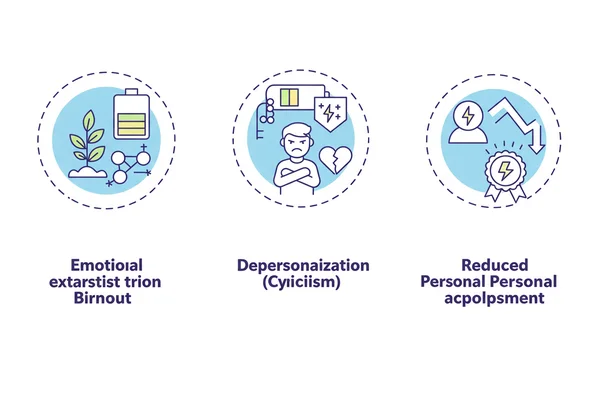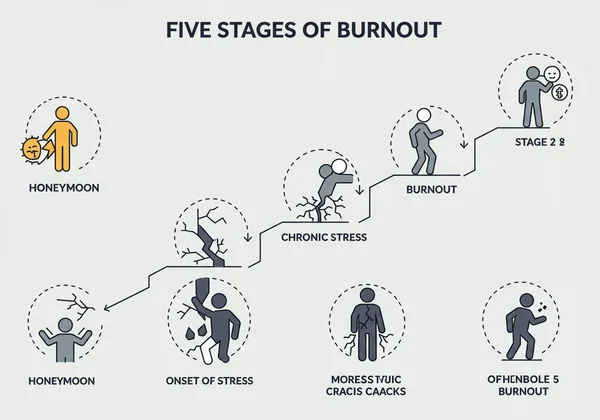Occupational Burnout Test: Guide to Symptoms, Stages & Recovery
Feeling perpetually drained, cynical about your job, and disconnected from your achievements? It might be more than just stress. This guide explores occupational burnout, its symptoms, stages, and recovery paths. What are the five stages of burnout? By the end of this guide, you'll have a clearer picture of your risk and know where to find support. If these feelings resonate, a confidential burnout test can provide clarity. Start with our online burnout assessment to understand where you stand.
Understanding Occupational Burnout: What Is It Truly?
Occupational burnout is a state of physical, emotional, and mental exhaustion caused by prolonged or excessive workplace stress. Unlike regular stress, which is often characterized by over-engagement, burnout is a state of disengagement. It’s a gradual process that chips away at your energy, motivation, and sense of purpose, leaving you feeling helpless, cynical, and resentful. Recognizing it is the first step toward reclaiming your well-being.

Defining Burnout: More Than Just Stress
While stress and burnout are related, they are not the same. Stress often involves a sense of urgency and hyperactivity—too many pressures that demand too much of you physically and mentally. However, stressed individuals can still see a light at the end of the tunnel. Burnout, on the other hand, is characterized by a feeling of emptiness and a lack of motivation. It's the sense that you have nothing more to give, and you no longer care.
The Three Core Dimensions (MBI Principles)
Researchers Christina Maslach and Susan Jackson defined burnout by three core dimensions, which form the basis of the Maslach Burnout Inventory (MBI). Understanding these is key to identification:
-
Emotional Exhaustion: This is the feeling of being completely drained and depleted of your emotional resources. You may feel tired all the time, unable to face another day at work, and lack the energy to be productive.
-
Depersonalization (or Cynicism): This dimension involves developing a negative, detached, or overly cynical attitude toward your job, colleagues, and clients. It's a psychological defense mechanism to cope with the overwhelming exhaustion.
-
Reduced Personal Accomplishment: This refers to a decline in your sense of competence and achievement at work. You may feel like you're no longer effective in your role, doubt your abilities, and struggle with a growing sense of failure.

Common Causes: From Workload to Lack of Control
Burnout doesn't happen overnight. It stems from chronic workplace stressors that are not effectively managed. Some of the most common contributors include:
- An unmanageable workload and excessive overtime.
- A perceived lack of control or influence over job decisions.
- Unclear job expectations or insufficient rewards.
- A dysfunctional workplace dynamic, such as bullying or a lack of social support.
- A mismatch between personal values and the company's mission.
Recognizing the Signs: Key Burnout Symptoms
Burnout affects your physical health, emotional state, and behavior. Identifying these signs early helps you take action before a crisis. Look for patterns across these areas to determine if you're experiencing burnout. If you recognize a pattern of these symptoms, a burnout test can help confirm your concerns.
Physical Manifestations: Fatigue, Headaches, Insomnia
Your body often keeps score of chronic stress. Physical symptoms are frequently the first warning signs that something is wrong. These can include:
- Chronic fatigue and feeling tired most of the time.
- Frequent headaches or muscle pain.
- Changes in appetite or sleep habits (insomnia or oversleeping).
- Lowered immunity, leading to more frequent illnesses.
Emotional & Psychological Indicators: Irritability, Detachment, Loss of Motivation
The emotional toll of burnout is significant and can change your entire outlook on work and life. Key indicators are:
- A sense of failure and self-doubt.
- Feeling helpless, trapped, and defeated.
- Detachment and feeling alone in the world.
- Loss of motivation and an increasingly cynical or negative outlook.
- Irritability and increased impatience with others.
Behavioral Changes: Procrastination, Isolation, Decreased Performance
Burnout directly impacts your actions and how you interact with your responsibilities and the people around you. You might notice:
- Withdrawing from responsibilities and isolating yourself.
- Procrastinating and taking longer to get tasks done.
- Using food, drugs, or alcohol to cope.
- Skipping work or consistently coming in late and leaving early.
- A noticeable drop in productivity and performance.
The Burnout Journey: Exploring the 5 Stages
Burnout is a progression, not an on/off switch. Researchers identified five stages to help you understand your journey and intervene early. Knowing your stage provides clarity.

Stage 1: The Honeymoon Phase (Enthusiasm & Overcommitment)
When you start a new job or take on a new role, you often experience high job satisfaction, commitment, and energy. In this phase, you willingly take on more than you can handle, driven by enthusiasm. The danger here is establishing unsustainable work habits.
Stage 2: Onset of Stress (Early Warning Signs)
The initial optimism begins to fade. You start noticing that some days are more difficult than others. You might feel early signs of stress, such as anxiety, fatigue, or irritability. Your focus may start to slip, and you find it harder to concentrate.
Stage 3: Chronic Stress (Persistent Symptoms)
The stress becomes more constant. The symptoms from Stage 2 intensify and become persistent. You might feel pressured and out of control, miss deadlines, and become more cynical. This is often the stage where your work performance visibly declines.
Stage 4: Burnout (Crisis & Exhaustion)
At this stage, the symptoms become critical. The feeling of exhaustion is overwhelming, and your cynicism deepens. You may feel numb, detached from your life, and question your career choices. Physical symptoms can become more intense, and you might feel an obsessive need to escape.
Stage 5: Habitual Burnout (Chronic Neglect & Detachment)
Burnout becomes so embedded it feels normal. This stage is marked by chronic sadness, deep mental and physical fatigue, and depression, severely impacting your career, relationships, and health.
Path to Recovery & Prevention: Taking Action Against Burnout
The good news is that burnout is not a permanent condition. With awareness and intentional action, you can recover and build resilience against future episodes. The journey starts with acknowledging the problem and taking small, manageable steps.
Self-Assessment: Your First Step to Understanding Your Risk
Before you can fix the problem, you need to understand its scope. A burnout test is a powerful tool for gaining objective insight into your level of burnout. It helps you move from "I feel tired" to "I am showing signs of high emotional exhaustion." A science-backed job burnout test provides a clear snapshot of your current state, empowering you with the knowledge to act.

Practical Strategies: Setting Boundaries, Stress Management & Self-Care
Recovery involves both organizational and individual strategies. On a personal level, you can:
- Set Firm Boundaries: Learn to say "no" to additional responsibilities. Disconnect from work emails and messages after hours.
- Prioritize Self-Care: Make time for exercise, healthy eating, and adequate sleep. These are non-negotiable for mental and physical recovery.
- Practice Mindfulness: Techniques like meditation, deep breathing, or yoga can help manage stress in the moment and build long-term resilience.
- Reconnect with Your "Why": Reflect on what you value in your work and life to reignite your sense of purpose.
Seeking Support: When to Talk to Your Boss or a Professional
You don't have to go through this alone. Consider discussing your workload and stressors with your manager to explore potential solutions. If your symptoms are severe or persistent, seeking help from a therapist or counselor is a sign of strength. They can provide professional guidance and coping strategies. Remember, tools like a burnout test are for screening and awareness, not as a substitute for professional medical advice.
Ultimately, understanding burnout is the most critical step toward reclaiming your health and happiness. It’s not a weakness but a signal that demands have exceeded your resources. By recognizing the signs and taking proactive steps, you can navigate back to a fulfilling professional life. Don't wait for a crisis. Take control today by discovering your burnout risk with our free, confidential assessment. Start your assessment and get the insights you need to move forward.
Frequently Asked Questions About Occupational Burnout
What are the five stages of burnout?
The five stages are: 1) The Honeymoon Phase (high enthusiasm), 2) Onset of Stress (early signs appear), 3) Chronic Stress (symptoms become persistent), 4) Burnout (crisis and exhaustion), and 5) Habitual Burnout (burnout becomes the norm).
What does burnout fatigue feel like?
Burnout fatigue is a profound sense of exhaustion that isn't relieved by rest. It's more than just feeling tired; it's a deep physical, mental, and emotional depletion that makes it difficult to function at work and in your personal life.
Is it burnout or am I just lazy?
Laziness is typically a choice or a lack of willingness to exert effort, while burnout is a state of inability due to complete exhaustion. If you once had motivation and drive for your work but now feel depleted and cynical, you are likely experiencing burnout, not laziness.
How do you test for burnout?
A burnout test uses scientifically validated self-assessment questionnaires, like those based on the Maslach Burnout Inventory (MBI). These tools measure the core dimensions of exhaustion, cynicism, and professional efficacy. For a quick and insightful evaluation, you can take our free burnout test to get instant results.